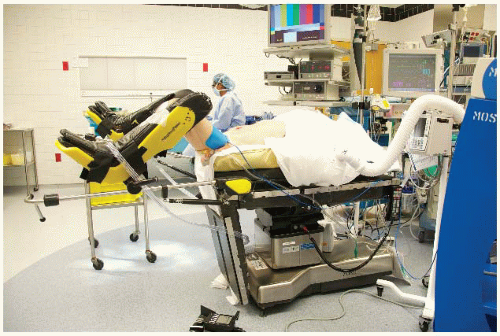Total Proctocolectomy with Ileal Pouch-Anal Anastomosis
KEY STEPS
1. Insertion of ports: 10-mm umbilical Hasson technique, 12-mm right iliac fossa, 5-mm right upper quadrant, 5-mm left upper quadrant, and 5-mm left iliac fossa.
2. Laparoscopic mobilization of the right colon and the terminal ileum.
3. Laparoscopic mobilization of the transverse colon and takedown of the splenic flexure, with division of middle colic vessels.
4. Laparoscopic mobilization of the left colon.
5. Mobilization and division of the upper rectum, the mesorectum, and the descending colonic mesentery.
6. Mobilization of the rectum to the upper anal canal.
7. Cross-stapling of the rectum, 2 cm above dentate line.
8. Exteriorization of the colon with resection and division at the terminal ileum.
9. Fashioning of the ileal pouch.
10. Return to laparoscopy and ileal pouch-anal anastomosis.
11. Loop ileostomy through single-port site.
ADDITIONAL ADVICE
1. Think of the procedure as four steps: right colectomy, transverse colectomy, left colectomy with proctectomy, and then creation of the ileal pouch.
2. If having difficulty in dividing the rectum with the stapler, getting an assistant to push up on the perineum with their hand may lift the pelvic floor enough to get the first cartridge of the stapler low enough.
3. The colon and the rectum are usually removed through the ileostomy site.
4. If additional reach is needed for the pouch to lie in the pelvis without tension, the peritoneum over the superior mesenteric artery can be opened with scissors and cautery to improve reach (“step laddering”).
PATIENT POSITIONING
The patient is placed supine on the operating table on a bean bag. After induction of general anesthesia and insertion of an oral gastric tube and Foley catheter, the legs are placed in yellow fin stirrups. The arms are tucked at the patient’s side and the bean bag is aspirated (Fig. 18.1). The abdomen is prepared with antiseptic solution and draped routinely (Chapter 2).
INSTRUMENT POSITIONING
The primary monitor is placed on the right side of the patient at the level of the hip. The operating nurse’s instrument table is placed between the patient’s legs. There should be sufficient space to allow the operator to move from either side of the patient to between the patient’s legs if necessary. The primary operating surgeon stands on the left side of the patient with the assistant standing on the patient’s right, and moving to the left side, caudad to the surgeon once ports have been inserted. A long 30-degree, 5-mm camera lens is used.
UMBILICAL PORT INSERTION
This is performed using a modified Hasson approach (Chapter 3). A vertical 1-cm subumbilical incision is made. This is deepened down to the linea alba, which is
then grasped on each side of the midline using Kocher clamps. Cautery is used to open the fascia between the Kocher clamps and Kelly forceps are used to open the peritoneum bluntly. It is important to keep this opening small (<1 cm) to minimize air leaks. Having confirmed entry into the peritoneal cavity, a purse string of 0 polyglycolic acid is sutured around the subumbilical fascial defect (umbilical port site) and a Rommel tourniquet is applied. A 10-mm reusable port is inserted through this port site allowing the abdomen to be insufflated with CO2 to a pressure of 12 mmHg.
then grasped on each side of the midline using Kocher clamps. Cautery is used to open the fascia between the Kocher clamps and Kelly forceps are used to open the peritoneum bluntly. It is important to keep this opening small (<1 cm) to minimize air leaks. Having confirmed entry into the peritoneal cavity, a purse string of 0 polyglycolic acid is sutured around the subumbilical fascial defect (umbilical port site) and a Rommel tourniquet is applied. A 10-mm reusable port is inserted through this port site allowing the abdomen to be insufflated with CO2 to a pressure of 12 mmHg.
LAPAROSCOPY AND INSERTION OF REMAINING PORTS
A 30-degree, 5-mm camera is inserted into the abdomen and an initial laparoscopy is performed carefully evaluating the liver, small bowel, and peritoneal surfaces. A long camera tends to keep the camera holders hand out of the way of the operating surgeon. Some surgeons favor a flexible tip camera.
A 12-mm port is inserted in the right lower quadrant approximately 6 to 8 cm medial and superior to the anterior superior iliac spine. In patients marked for a temporary ileostomy, the port is placed through this site, paying careful laparoscopic attention to the position of the inferior epigastric vessels to avoid injury. A 5-mm left lower quadrant port is used in order to permit use of an energy source when ligating the ileocolic pedicle and middle colic vessels. This port site may be upsized to 10 mm in size as needed to accommodate the energy sources. Five-millimeter ports are then inserted in the right upper quadrant and left upper quadrant at least a hand’s breadth superior to the lower quadrant ports. The left-sided ports are kept lateral to the epigastric vessels (Fig. 18.2).
DEFINITIVE LAPAROSCOPIC SETUP
The surgeon and the assistant now move to the patient’s left side, with the assistant standing caudad to the surgeon. The patient is rotated with the right side up and left side down, to approximately 15 to 20 degrees tilt. This helps to move the small bowel over to the left side of the abdomen. The patient is then placed in the Trendelenburg position. This again helps gravitational migration of the small bowel away from the operative field. The surgeon then inserts two atraumatic bowel clamps through the two remaining ports on the device. The greater omentum is reflected over the transverse colon so that it comes to lie on the stomach. If there is no space in the upper part of the abdomen, one must confirm that the orogastric tube is adequately decompressing the stomach of gas.
Stay updated, free articles. Join our Telegram channel

Full access? Get Clinical Tree









